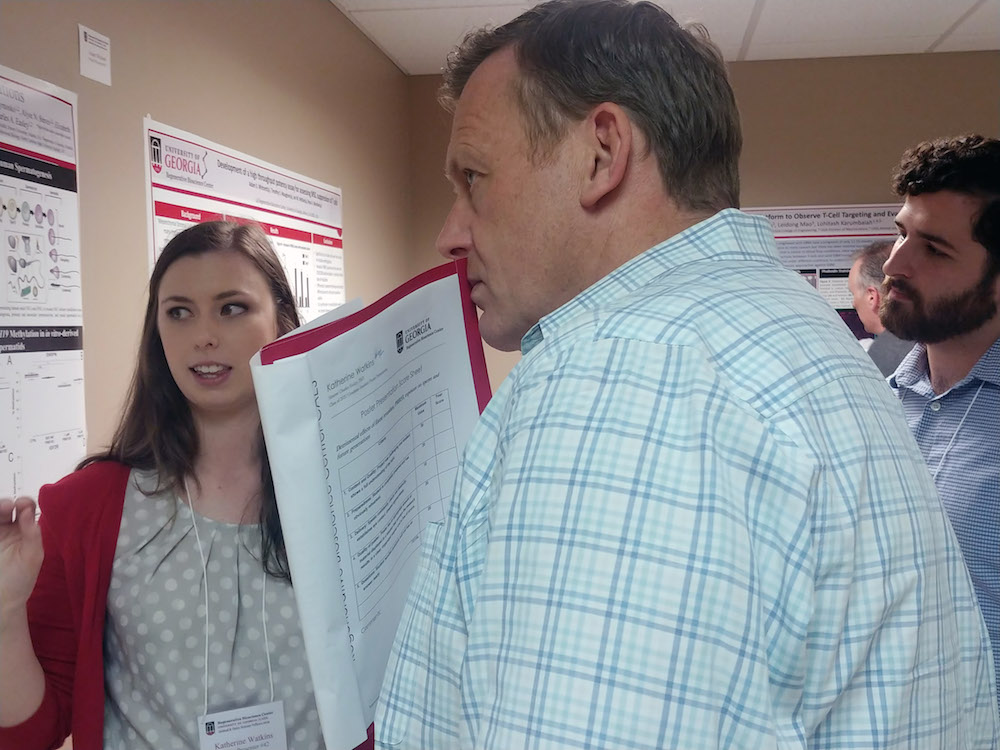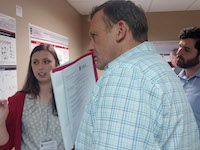Students were confident, students were beaming, students were energized, and from the minute you walked in the door at the Edgar Rhodes Animal & Dairy Science Building on the last Friday in April, you were eager to share in the thrill of research discovery.
The 5th annual Regenerative Bioscience Center Fellows Symposium drew more than 54 student participants. The gathering included not only faculty, undergraduate, graduate students and post-docs from across the University of Georgia, but included high-ranking administrators throughout the RBC’s seven affiliated colleges.
“The College of Agricultural and Environmental Sciences is proud to be the home of the Regenerative Bioscience Center. It is certainly one of our brightest points of pride,” said Sam Pardue, UGA CAES dean and director of academic programs. “Our animal and dairy scientists in the center are some of the world’s leading experts in innovative areas of research that feeds regenerative bioscience. Their innovation and dedication to seeking solutions and cures for these devastating conditions is remarkable for both human and animal health and quality of life. These RBC Fellows are truly fortunate to work side-by-side with such ground-breaking scientists.”
The annual RBC symposiums are generally focused around the center’s core research projects of stroke, neurological injury, and orthopedic conditions. The 2019 event titled Climb Higher included students in the CAES Animal and Dairy Science program.
“Today’s event was a valuable opportunity to showcase ongoing efforts and to highlight the close, interdepartmental partnership between the RBC and ADS,” said newly appointed ADS department head, Francis Fluharty.
Fluharty, who sponsored the event, saw the opportunity to align initiatives so that both the center and the department can share resources and expertise to benefit an even larger group of students. Because of his ongoing efforts, the ADS invigorated spotlight is rapidly being shared by regenerative biotechnology, including the development and practical application of animal models for human diseases and production of pharmaceuticals.
“This is a great opportunity for ADS to continue to expand upon its agricultural and medical biotechnology research and to recognize the diversity and interest of training among our students,” said Fluharty. “Animal science today is a lot more than people realize.”
Audience participants viewed poster presentations and heard talks about subjects ranging from biomedical techniques being developed that hold promise for treating Parkinson’s, stroke and Alzheimer’s’ disease — to healing joint deterioration and alleviating osteoarthritis — to genomic selection in catfish.
“It is very clear that the students here at RBC and ADS are having a truly transformative research experience that will affect their trajectory for years to come,” said Franklin West an associate professor of CAES animal and dairy science and founding developer and leader of the RBC Fellows program.
West noted that the Fellows Graduate Student Association solicited judges from different disciplines, and noted the importance to ensure diverse, fair judging and for students to receive valuable feedback from people outside of their field.
“I think the symposium is a fantastic opportunity for all students. I had the opportunity to talk to a high school student, all the way up to a senior university graduate student,” said Fellows judge, Jarrod Call, assistant professor of kinesiology.
“Each had a real command for what they did,” he added. “How they helped out with their research projects, and the larger significance of it.”
Forty-six poster presenters set out to implement research discovery through a series of projects they have been working on for months — some for years. The first student to sign-up for the event was Krista Symosko, from the Lab of Charles Easley, assistant professor of environmental health science.
“We are developing a screening platform for a potential male contraceptive, one that we hope is going to help form a team approach to family planning and relieve the burden placed on women,” Symosko said. “It’s great to have a symposium like this, with an audience who is really interested in our work.”
Attendees gathered around Hannah Kemelmakher a fourth-year undergraduate biochemistry major working in the lab of John Peroni, DVM, MS, DACVS, to hear her talk about joint deterioration as seen in osteoarthritis.
“Actually I'm so proud of this work because I can talk to my grandparents and talk to my parents about it and how they relate to it,” Kemelmakher said. “I’ve presented at four other symposiums, more than any other, this is by far — true collaboration — from engineering, genetics, vet med, and animal modeling, something I believe health and medicine research requires.”
Morgan Goeden and Min Kyoung Sun presented their work from the lab of Lohitash Karumbaiah, associate professor of regenerative medicine in CAES. The students each discussed potential treatments for traumatic brain injury (TBI).
“Our work is with TBI treatments and the designing of a hydro gel to grow neural stem cells. Since stem cells don't typically survive very well after injury, our gel will someday serve as a vehicle to navigate a toxic environment swarmed by injury to better help those cells survive,” said Goeden, who recently presented at the National Conference on undergraduate research hosted by Kennesaw State University.
“Even though I see my colleagues every day, we don’t often spend time talking about each other’s research,” said Sun, who is working on testing exosomes as a direct therapeutic for TBI. “So it’s interesting to visually see their work in a poster format and get to talk about what they’re doing.”
Students from the CAES ADS Lawton Stewart lab presented posters on goats and cattle nutrition. Shane Hernandez, graduate student in the Stewart lab, commented about cellular therapy combined with the design to create products that respond to both human and animal health including the crossover between his work and student research in the RBC.
“The researchers in the RBC, for instance, have pioneered the specific details for an application side and we, to some extent, are the market that tests and makes the product better, cleaner and safer,” Hernandez said. “I like to think about it as one health initiative, the more we work to understand each other’s research, the more we will both be better prepared.”
Graduate student, Dylan Davis, echoed his lab mates sentiments on the crossover of ADS and RBC research.
“I think the next step is to take our research on cottonseed rations down to the molecular level,” Davis said. “I'm kind of looking at it from a 30,000-foot view, so I definitely think with the RBC’s help there is room to try to incorporate some more in-depth cellular investigations into how Gossypol, found in cottonseed plants, specifically acts inside the animal, too.”
One of the easiest ways to get people talking at a symposium is to ask questions about their presentation. Mohamed Ishan, a young enthusiastic investigator working on taste buds in the lab of Hongxiang Liu, associate professor of ADS, loves to talk, and understands the importance of networking and navigating a scientific career.
“Any opportunity to share my work and gain new insight into research outside of mine, will build my confidence as an independent researcher and help me to build the foundations for my scientific career,” Ishan said.
Eight students were selected to present in 10-minute oral presentations.
To kick off, guest speaker Ana Maslesa, an RBC undergraduate student working in the Mortensen Lab, led with an overview of her four-year RBC experience. Maslesa, who is attending Morehouse School of Medicine in the fall, left the audience with no choice but to cheer for sharing such a memorable experience.
“Relationships with my lab mates is really special, it’s a huge part of my undergraduate career,” she said. “I felt like an integral part of the lab and that my work mattered, and most of all, that people needed me.”
Before the break, the audience heard from Samantha Spellicy, dual RBC graduate and medical student, on the utility of an animal model in stroke disease.
“What was really interesting about this project, was finding some correlations between our animal models and a certain MRI parameter that no one else has been able to show before,” Spellicy said. “These are also very primitive to clinical measurements used in human studies and in human diagnosis, which match up with our animal model. It’s been extremely exciting knowing we have clinically relevant animal stroke models that can actually help us to develop better therapeutics and testing.”
Spellicy’s mentor is Steven Stice, Director of the RBC, and distinguished DW Brooks Professor in the College of Agricultural and Environmental Sciences.
“This year’s symposium highlights the college’s continued commitment to melding animal and dairy science with regenerative medicine,” said Stice. “With all the excitement surrounding today’s event, we look forward to hosting more in the future.”
2019 Climb Higher winners: Oral competition: First place, Charles Latchoumane, postdoc. Advisor: Lohitash Karumbaiah. Second place, Rachael Hart Earls, graduate student. Advisor: Dr. Jae-Kyung (Jamise) Lee. Third place: Samantha Spellicy, graduate student. Advisor: Steven Stice. Poster competition: First place, Kelly Scheulin, graduate student. Advisor: Franklin West. Second place, Mason Wolfe, undergraduate. Advisor: Lohitash Karumbaiah. Third place, Madeleine Schwab, undergraduate. Advisor: Luke Mortensen.
View images from the symposium at https://adobe.ly/2vBPsxf.








